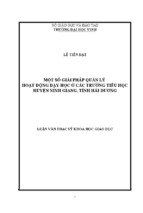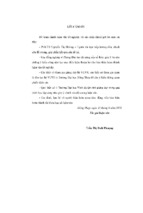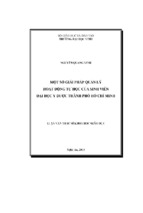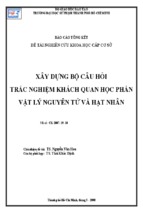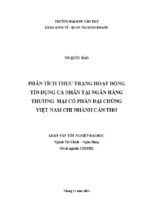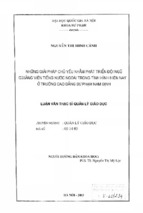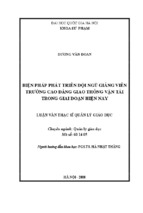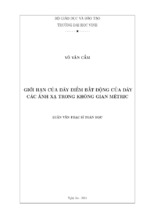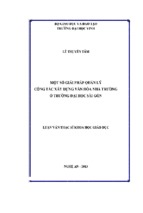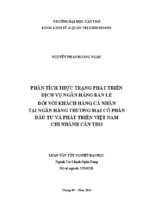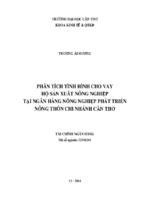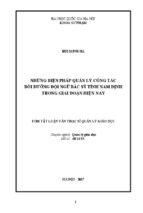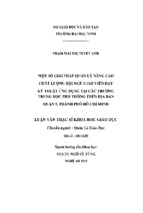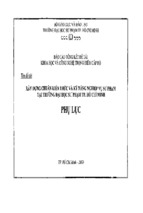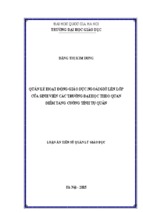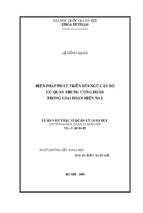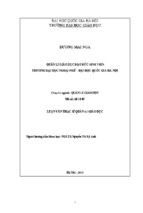VIETNAM NATIONAL UNIVERSITY, HANOI
UNIVERSITY OF LANGUAGES AND INTERNATIONAL STUDIES
FACULTY OF POST- GRADUATE STUDIES
NGUYỄN THỊ THANH HÀ
APPLYING PROBLEM-SOLVING ACTIVITIES TO TEACH
SPEAKING SKILLS TO THE SECOND YEAR ENGLISH-MAJOR
STUDENTS AT VIETNAM UNIVERSITY OF COMMERCE
ÁP DỤNG CÁC HOẠT ĐỘNG GIẢI QUYẾT VẤN ĐỀ TRONG
DẠY NÓI CHO SINH VIÊN NĂM THỨ HAI CHUYÊN ANH
TẠI ĐẠI HỌC THƯƠNG MẠI
M.A MINOR PROGRAMME THESIS
Field : English Teaching Methodology
Code : 60.14.10
HANOI, 2014
VIETNAM NATIONAL UNIVERSITY, HANOI
UNIVERSITY OF LANGUAGES AND INTERNATIONAL STUDIES
FACULTY OF POST- GRADUATE STUDIES
NGUYỄN THỊ THANH HÀ
APPLYING PROBLEM-SOLVING ACTIVITIES TO TEACH
SPEAKING SKILLS TO THE SECOND-YEAR ENGLISH-MAJOR
STUDENTS AT VIETNAM UNIVERSITY OF COMMERCE
ÁP DỤNG CÁC HOẠT ĐỘNG GIẢI QUYẾT VẤN ĐỀ TRONG
DẠY NÓI CHO SINH VIÊN NĂM THỨ HAI CHUYÊN ANH
TẠI ĐẠI HỌC THƯƠNG MẠI
M.A MINOR PROGRAMME THESIS
Field : English Teaching Methodology
Code : 60.14.10
Supervisor: Assoc. Prof. Dr. Trầ n Xuân Điêp̣
HANOI, 2014
DECLARATION
I hereby certify that the minor thesis entitled: “Applying Problem-Solving
Activities in Teaching Speaking Skills for the Second-year English-Major Students
at Vietnam University of Commerce” is the result of my own research to fulfill the
MA Degree at Post-Graduate Department, University of Languages and
International Studies, Vietnam National University, Hanoi. The substance of this
thesis has not, wholly or partially, been submitted for degree to any other university
or institution.
Signature
Nguyen Thi Thanh Ha
i
ACKNOWLEDGEMENTS
I would love to express my deep indebtedness to a number of people whose
invaluable support and encouragement were of great help in the completion of this
study.
First and foremost, I would like to advance my special gratitude and respect to
my minor thesis advisor, Assoc. Prof. Dr. Tran Xuan Diep for his invaluable
suggestions, continuous support, great encouragement, motivating attitude as well
as critical comments from the beginning of my study. I could never have achieved
this without his support.
I am also thankful to all my teachers at the English department, University of
Languages and International Studies, Vietnam National University, Hanoi.
My special thanks to 40 second-year students at Vietnam University of
Commerce for their invaluable support and cooperation to start and complete my
thesis.
Lastly, my special words of thanks are extent to my family for their endless help,
patience and support.
ii
ABSTRACT
The current study entitled “Applying Problem-Solving Activities in Teaching
Speaking Skills for the Second-year English-Major Students at Vietnam University
of Commerce” was carried out to find out the effectiveness of problem-solving
activities in improving students‟ speaking competence as well as investigate the
students‟ motivation towards the use of problem-solving activities in speaking
lessons at Vietnam University of Commerce (VUC), and then give some
pedagogical implications for teachers. An action research was implemented with 40
students of English Department at VUC during four weeks. Data were collected by
observations, oral tests, questionnaires, and student‟s journals. To answer two
research questions (1) To what extent does the application of problem-solving
activities improve students‟ speaking skills? and (2) What are the effects of
problem-solving activities on students‟ motivation?, four speaking lessons were
conducted in the form of problem-solving activities. The main findings highlighted
the students‟ improvement in speaking skills after the treatment. This was shown by
the students‟ journals and comparisons of results of oral pre-test and post-test,
which have the same format and criteria for assessing. The analyses of the postintervention questionnaire and observation sheet also indicated that the students are
more interested and involved in speaking lessons. Thus, it is expected that the
results of this study could benefit English teachers in general and English teachers
in VUC in particular to enhance their speaking lessons.
iii
LIST OF ABBREVIATIONS, TABLES AND FIGURES
Table 1: Procedures of the Study ..............................................................................25
Table 2: Results of Question 1 in the Questionnaire Before the Intervention ..........27
Table 3: Results of Question 2 in the Questionnaire Before the Intervention ..........27
Table 4: Results of Question 3 in the Questionnaire Before the Intervention ..........28
Table 5: Results of Question 4 in the Questionnaire Before the Intervention ..........28
Table 6: Results of Question 5 in the Questionnaire Before the Intervention ..........29
Table 7: Means and Standard Deviations of the Scores of the Pre-test and Post-test
...................................................................................................................................31
Table 8: Correlations of the Pre-test and Post-test ..................................................31
Table 9: Paired Sample T-Tests ................................................................................32
Table 10: Students’ Level of Involvement .................................................................35
Table 11: Students’ Interest and Benefits .................................................................36
Figure 1: Action Research Model ( Kemmis, 1988) .................................................19
Figure 2: Comparison of Results of Pre-test and Post-test ......................................30
Figure 3 Students’ Level Motivation .........................................................................34
Abbreviation
VCU: Vietnam University of Commerce
iv
TABLES OF CONTENTS
PART A: INTRODUCTION ........................................................................................................... 1
1.1. Rationale of the Study ......................................................................................1
1.2. Aims of the Study .............................................................................................2
1.3. Objectives of the Study ....................................................................................2
1.4. Research Questions ..........................................................................................2
1.5. Scope of the Study ............................................................................................3
1.6. Significance of the Study ..................................................................................3
1.7. Methodology ......................................................................................................3
1.8. Design of the Study ...........................................................................................4
PART B: DEVELOPMENT ............................................................................................................ 5
CHAPTER 1: THEORETICAL BACKGROUND AND LITERATURE REVIEW ... 5
1.1. Theoretical Background .................................................................................. 5
1.1.1.
An Overview of Speaking .......................................................................5
1.1.1.1.
Some Concepts of Speaking ...................................................................5
1.1.1.2.
The Roles of Speaking Skills in Language Teaching ...........................6
1.1.1.3.
Principles of Teaching Speaking ...........................................................7
1.1.1.4.
Classroom Speaking Activities ...............................................................7
1.1.2.
Problem-Solving Activities .....................................................................8
1.1.2.1.
Definitions of Problem Solving ..............................................................8
1.1.2.2.
Kinds of Problem-Solving activities .....................................................10
1.1.2.3.
Advantages of the Application of Problem-Solving Activities in
Teaching Speaking ...................................................................................................11
1.1.3.
Procedures of Conducting Problem-Solving Activities in a Group ...13
1.2. Review of Related Works...............................................................................14
v
1.3. Justification for the Study .............................................................................15
1.4. Summary .........................................................................................................16
CHAPTER 2: RESEARCH METHODS...................................................................................17
2.1. The Setting ........................................................................................................17
2.2. Subjects .............................................................................................................18
2.3. Research Approach ..........................................................................................18
2.4. Data Collection Instruments ...........................................................................19
2.4.1. Speaking Pre-test and Post-test .....................................................................19
2.4.2. Questionnaires ................................................................................................20
2.4.3. Observation Sheet ...........................................................................................20
2.4.4. Students’Journals...........................................................................................21
2.5. Intervention: The Application of Problem-Solving Activities .....................21
2.6. Data Collection Procedures ...........................................................................24
2.7. Data Analysis ..................................................................................................25
2.8. Summary .........................................................................................................26
CHAPTER 3: FINDINGS AND DISCUSSIONS ....................................................................27
3.1. Preliminary Investigation ................................................................................27
3.1.1. Findings ..........................................................................................................27
3.1.2. Discussion .......................................................................................................29
3.2. Evaluation .........................................................................................................30
3.2.1. Research Question 1.......................................................................................30
3.2.1.1. Results from Pre-test and Post-test .............................................................30
3.2.1.2. Discussion ....................................................................................................32
3.2.1.3. Results from Students’ Journals ................................................................33
3.2.2. Research Question 2.......................................................................................34
3.2.2.1. Results from Observation Sheet..................................................................34
vi
3.2.2.2. Discussion ....................................................................................................35
3.2.2.3. Results from Questionnaire 2 .....................................................................35
3.2.2.4. Discussion ....................................................................................................37
3.3. Summary ...........................................................................................................37
PART C: CONCLUSIONS ............................................................................................................39
4.1. Recapitulation of Main Ideas ..........................................................................39
4.2. Limitations of the Study ..................................................................................40
4.3. Suggestions for Further Studies......................................................................40
REFERENCES ..................................................................................................................................41
APPENDICES………………………………………………………………………I
vii
PART A: INTRODUCTION
1.1.
Rationale of the Study
Among four skills, speaking plays the most essential part in communication. In
fact, Vietnamese students realize the necessity as well as importance of enhancing
language skills in order to meet future job‟s needs and communicate in social
conversations. However, it is hard for most of them to use English in the real
situations. In the real context of Vietnam University of Commerce, lecture-oriented
method is still applied at present although there have been a large number of
changes about teaching materials and supplementary activities. Students do not feel
elated and enthusiastic when participating in speaking lessons. Their lack of
confidence as well as uninteresting speaking activities leads to demotivate them to
join in. In addition, other problems such as lack of vocabulary, involvement or
enjoyment have great impacts on their participation in speaking lessons.
To solve these problems, more effective speaking activities need to be exploited
so as to enhance learners‟ communicative competence and help them get more
involved in speaking lessons, so current teachers need to actively engage students in
speaking activities that are enjoyable and are based on a more communicative
approach. One of them is problem-solving activities, which received many supports
from scholars and teachers. Using problem-solving activities is regarded as an
effective way to practise communication skills in which students work with each
other to find out appropriate solutions to a specific problem. Therefore, this is a
good chance for them to interact with teachers or other students, which encourage
them to be more cheerful and inspired. Moreover, their discussion will help them
share information, create new ideas and boost their self-confidence. Thus, their
speaking skill will also be improved. Students use target language as a means to
solve a problem, which also increases their motivation, participation and critical
thinking.
1
The above mentioned situation has urged the researcher to conduct a study of
“Applying Problem-solving Activities in Teaching Speaking Skills to the Secondyear English-Major Students at Vietnam University of Commerce”. This study is
intended to make a contribution to helping students at Vietnam University of
Commerce improve their speaking skills.
1.2.
Aims of the Study
The study aimed at finding out whether the application of problem-solving
activities has a positive impact on the speaking skills of the Second-year EnglishMajor Students at Vietnam University of Commerce. Then, suggestions on how to
use problem-solving activities effectively to enhance students‟ speaking
competence are given.
1.3.
Objectives of the Study
The specific objectives of the study were as follows:
To investigate the extent to which the application of problem-solving activities
has improved the speaking competence of the Second-year English-Major
Students at Vietnam University of Commerce.
To exploit the effects of problem-solving activities on students‟ motivation in
speaking skills.
1.4.
Research Questions
In this investigation, the following research questions were addressed:
1. To what extent does the application of problem-solving activities improve
students’ speaking skills?
2. What are the effects of problem-solving activities on students’ motivation?
2
1.5.
Scope of the Study
The study was conducted on 40 Second-year English-Major Students at Vietnam
University of Commerce in the first semester of 2014-2015 via the application of
problem-solving activities in teaching speaking skills.
1.6. Significance of the Study
The foremost significance of this study is that it will contribute to a more
effective use of problem-solving activities in order to enhance speaking skills for
the Second-year English-Major Students at Vietnam University of Commerce.
The findings of the study will provide an insightful understanding of the current
situation of exploiting problem-solving activities in teaching speaking skills to the
Second-year English-Major Students at Vietnam University of Commerce. In other
words, the study also helps revisit the features and principles of problem solving in
education. Moreover, English teachers may find the recommended problem-solving
activities a useful reference to make their speaking lessons more communicative,
meaningful and practical.
1.7. Methodology
An action research was applied in this minor thesis to improve students‟
speaking skills and teaching speaking in the researcher‟s own class. In order to
collect sufficient and relevant data for the study, four instruments were employed:
- Pre-test and post-test to assess student‟s speaking ability.
- Observation sheet to find out students‟ motivation during the intervention.
- Survey questionnaires to investigate students‟ achievement and motivation before
and after the intervention.
- Student‟s journals to investigate students‟ improvement towards this application.
3
1.8. Design of the Study
The study consists of three parts: Introduction, Development and Conclusion.
The Introduction presents the rationale, aim, objectives, scope, significance and
methodology.
The Development includes three chapters which are as follows:
Chapter One covers an in-depth review of the literature in which a relevant
theoretical background and a review of related studies concerning applying
problem-solving activities in teaching speaking skills.
Chapter Two features the research methods including the background information
of the context, the subjects of the study, the instruments used to collect data, and the
procedures of data collection and data analysis. Moreover, a detailed description of
data analysis is provided.
Chapter Three shows the findings and discussions, the results of the study are
shown.
The Conclusions ends the report with the recapitulation of main ideas, the
limitations of the study and the suggestions for further studies.
4
PART B: DEVELOPMENT
CHAPTER 1: THEORETICAL BACKGROUND AND LITERATURE
REVIEW
1.1.
Theoretical Background
1.1.1. An Overview of Speaking
1.1.1.1.
Some Concepts of Speaking
Speaking skill plays an essential role in teaching and learning a foreign
language. There are a variety of views on the term “speaking” given by different
linguists.
According to Chaney (1998), “Speaking is the process of building and sharing
meaning through the use of verbal and non-verbal symbols in a variety of contexts”
(p. 13). While Byrne (1986, p. 8) defined that speaking is “a two-way process
between speaker and listener, involving the productive skill of speaking and the
receptive skill of understanding”. The speaker plays the role of encoding the
message to be conveyed in an appropriate language, while the listener has to decode
the message. A similar view of “speaking” given by Scott, R. (1981) was that
speaking is “an activity involving two (or more) people in which the participants are
both hearers and speakers having to react to what they hear and make their
contributions at high speed”. Through the interaction, each participant will try to
achieve his communicative goals and fulfill his ability of interpreting what is said to
him. Expressing message or sharing information through verbal and non-verbal
symbols is actually effective ways in real-life situations which will help people
understand each other without words. Theodore Huebner stated that “language is
essentially speech, and speech is basically communication by sounds”. According to
him, speaking is a skill used by someone in daily life communication whether at
school or outside. The skill is acquired by much repetition; it primarily a
neuromuscular and not an intellectual process. It consists of competence in
sending and receiving messages.
5
To sum up, it is obvious that speaking is one of the most important skills for
learners. The ability to speak fluently, appropriately and understandably every time,
everywhere and in every situation is the goal as well as the desire of language
learners. It is not easy for them to master immediately because speaking skills
require learners to practice regularly and patiently. From these reasons, Bygate
(1987, p. 2) considered speaking skills as “a skill which deserves attention every bit
as much as literary skills in both first and second language”.
1.1.1.2.
The Roles of Speaking Skills in Language Teaching
Speaking creates motivation in language learning. According to Crook and
Schmidt (1991), motivation is defined as the learner‟s orientation with regard to the
goal of learning a second language. Learning a language is to know to learn how to
use it, as Nunan (1991) stated “success is measured in terms of the ability to carry
out a conversation in the (target) language”. Mastering a language is that learners
can use it flexibly in every situation. If students cannot speak or they do not have a
chance to speak, they will get bored and lose their interest in learning a language.
Therefore, the right activities need using in a right way, which makes speaking in
class be cheerful and raises learners‟ motivation as well as creates a dynamic
English language classroom.
Speaking also helps other language skills be improved. It is obvious that
speaking and listening are the two inter-dependent macro skills. A student who is
good at speaking is more likely to be good at listening than the others. A student
who speaks English well also has a higher chance of reading and writing English
better than the others (Nation, 1990, p.21).
Speaking is fundamental to human communication. In fact, we speak more than
we write, whereas many English teachers still spend the majority of class time on
reading and writing. Speaking and listening skills are not really esteemed.
Therefore, this creates an unbalance among these skills. If the goals of the language
6
course are to help students communicate English, speaking skill should be regularly
taught and practiced in a language classroom.
1.1.1.3.
Principles of Teaching Speaking
Speaking plays a significant role in developing communicative competence, and
teachers‟ responsibility is to equip students with knowledge and skills to be able to
use English for communication in the real world.
Thus, Harmer (2001: 102)
suggested some principles in teaching speaking. First of all, speaking helps students
overcome their initial reluctance, which helps them be more motivated. Secondly,
students are asked to talk about what they want to talk about. Next, teaching
speaking requires appropriate feedback to be provided. The last one is that speaking
is also combined with listening and reading.
1.1.1.4.
Classroom Speaking Activities
Speaking is regarded as a means of effective communication. The question of
how to increase communicative competence is the most crucial one. Many speaking
activities suggested by researchers and educators are useful for teachers in
improving the quality of speaking lessons and promoting students‟ attitudes and
participation in learning a language.
Harmer (2001, p.271-274) proposed some speaking activities. The first one is
acting from a script. In this section, teachers ask students to perform the play based
on the dialogue in the script. Thus, the teacher as a director and the students perform
the dialogue. Communication games are the second one which can make students
relaxed in learning a language. This technique is particularly suitable for the
children in mastering the language. It is designed to provoke communication
between students in order for them to solve a puzzle, draw a picture, put the things
in a right order, and find differences between pictures. Lastly, it is Role Play that is
a stimulated activity in which students pretend that they are in a different situation,
either as themselves or playing the role of someone is quite different. We could ask
7
them to be a guest at some parties and go there as different characters. They could,
as themselves, pretend to be at an airport trying to check luggage, or either as
themselves or another character take part in a television program. The students in all
these cases are using language in order to participate in the activity rather than other
way round. Some students find it very comfortable to use language in a simulated
environment, and playing the role of someone else which allows them to experiment
freely to be another people.
1.1.2. Problem-Solving Activities
1.1.2.1.
Definitions of Problem Solving
Problem solving is a popular way to stimulate students‟ interest and motivation.
Students work in pairs or groups to share their opinions and feelings about a
specific problem. They work together to discuss, analyze and evaluate the problem,
then reach proper solutions.
A problem is a situation which is experienced by an agent as different from the
situation which the agent ideally would like to be in. A problem is solved by a
sequence of actions that reduce the difference between the initial situation and the
goal (F.Heylighen, 1998).
According to Ormond (2006: 111), “problem solving is using existing
knowledge and skills to address an unanswered question or a troubling
situation”.
Mayer and Wittrock (2006, p. 287) defined problem solving as “a cognitive
process directed at achieving a goal when no solution method is obvious to the
problem solver”. This definition consists of four parts:
Problem solving is cognitive, that is, problem solving occurs within the
problem solver's cognitive system and can only be inferred from the
problem solver's behavior.
8
Problem solving is a process, that is, problem solving involves applying
cognitive processes to cognitive representations in the problem solver's
cognitive system.
Problem solving is directed, that is, problem solving is guided by the
problem solver's goals.
Problem solving is personal, that is, problem solving depends on the
knowledge and skill of the problem solver.
In Longman Dictionary of Language Teaching and Applied Linguistics
(Richards, J. C., Platt, J., & Platt, H. 1997), problem-solving activities are defined
as simple tasks, often involving word puzzles or simple drawings, used to stimulate
pair work and oral discussion among small groups of second language learners. The
use of such tasks is characteristic of some phases of lessons in the communicative
approach.
In the book “Keeping Talk” (1984), Klippel presented that in problem-solving
activities, learners have to find solutions to various types of problem. They must
work together to discuss several ways of solving the problems in pairs or groups.
There are many kinds of problem-solving activities shown in this book which are
useful for learners to practise speaking skills such as making suggestions, giving
reasons and modifying.
In problem-solving activities, learners have to share their feelings and opinions,
analyze and evaluate the problems to reach a decision together. Shumin (1997)
stated that “problem solving is directed towards the solving of a specific problem
that involves both the formation of responses and the selection among possible
responses”.
Problem solving is one of many communicative interactive techniques for
language teaching that received many attentions from researchers and educators.
Littlewood (1990) proposed that “problem-solving activity is a type of
communicative activities that have been designed to provide opportunities for
9
learners to produce a language that they have recently learnt”. The application of
problem-solving activities encourages students to think carefully and talk together
to seek solutions to tasks or problems. Moreover, these activities increase students
„participation and motivation towards speaking skills. In other words, they also
create a fascinating and eventful learning environment to help learners understand
more about the importance and necessity of speaking skills.
1.1.2.2.
Kinds of Problem-Solving Activities
A number of kinds of problem-solving activities have been used for teaching
language in EFL classrooms. These activities are organized in different ways in
which their main aim is to enhance speaking skills.
Byrne (1986, p. 94) proposed different some problem solving activities which
are as follows:
Linking activities:
Finding connections: Students have to establish connections between two
items (presented to them verbally or in the form of pictures). Two such
items might be horse and book. Some possible connections are:
(1)
The horse is famous because it has won lots of races, so its owner has
decided to write a book about it.
(2)
The horse belongs to a man who likes reading and riding. When he
goes for a ride on his horse, he often takes a book with him to read.
Finding differences and similarities: Students may be asked to find
differences and similarities as two separate activities or as part of the same
activity. For example, Students can be asked to find differences (either a set
number or as many as possible) between two pictures. Or students can be
asked to list both similarities and differences (for office and classroom).
Categorising activities:
10
Putting items in categories: Students are given a list of items and asked to
locate these under headings according to different features. For example:
Everyday
objects
can
be
divided
into
essential/
non-essential;
cheap/expensive; imported/home-produced.
Identifying categories: Students are given a list of items and asked to
identify for themselves the categories into which the items can be arranged.
They may be asked to find a set number of categories or as many as
possible. For example, for clothes, some categories might be: worn all the
year round/worn only in winter; or with sleeves/ without sleeves.
Grading activities:
Grading: This involves putting a list of items in order according to certain
agreed criteria. For example: Students can be asked to grade the subjects
they study at school on a scale from most to least difficult (interesting,
useful and so on)
Deciding on priorities: Students have to put in order of priority, or they can
also be asked to put in order of importance (such as a school or a social
club)
Planning activities:
Planning a picnic: Students have to decide: when, where and how to go,
what to take and what to do. Similarly, students can be asked to plan a
party.
Planning a park: Students have to decide what facilities they would like
their park to have and also where they would like these sited.
1.1.2.3.
Advantages of the Application of Problem-Solving Activities in
Teaching Speaking
It is essential to provide students with a variety of speaking activities so that
they will be able to cope with different situations in a real life. Speaking activities
11
- Xem thêm -


